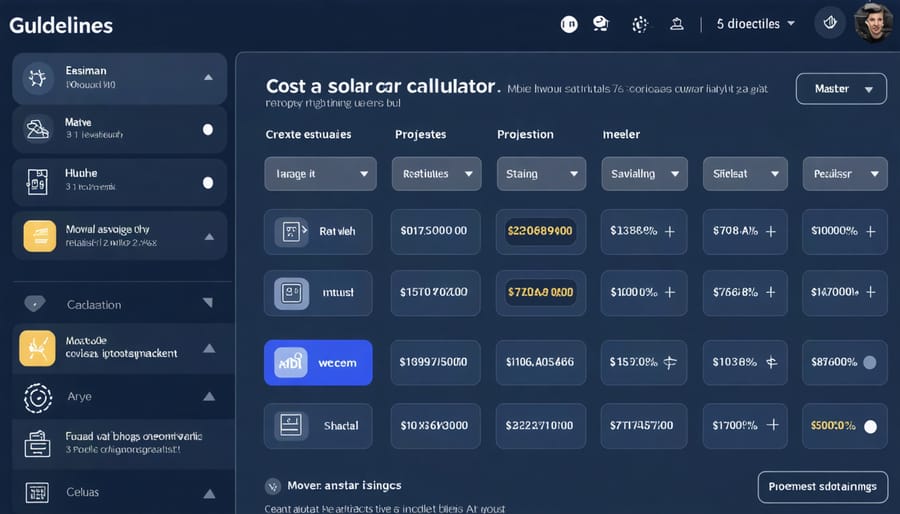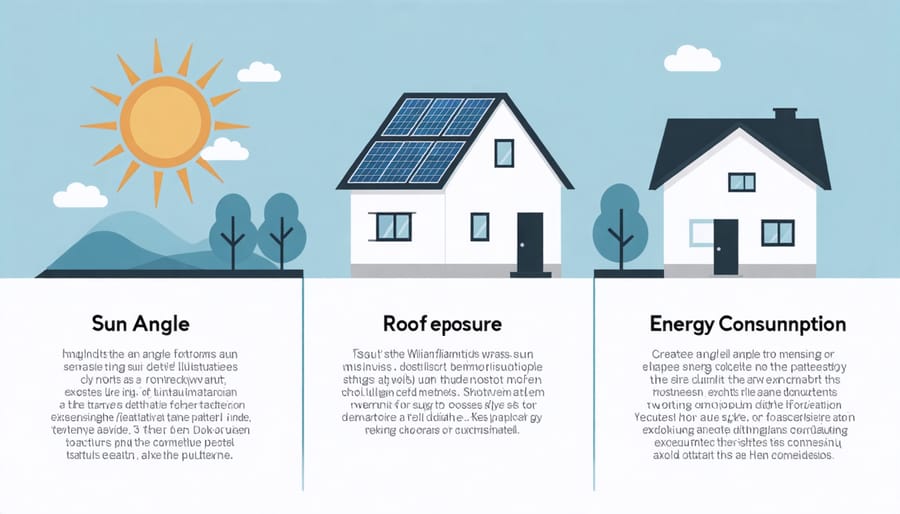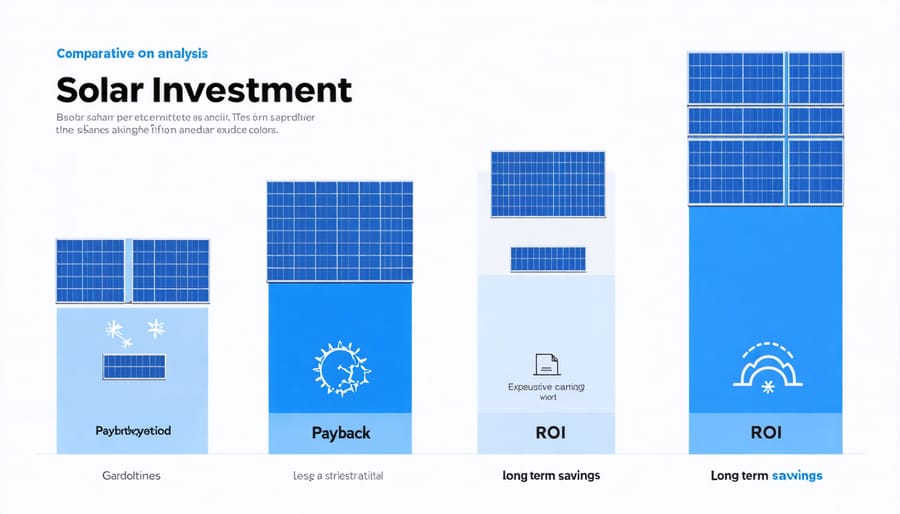Making the switch to solar power represents one of the most significant financial decisions a homeowner can make – but understanding the true return on investment doesn’t have to be complicated. Today’s solar installations typically pay for themselves within 5-10 years through reduced electricity bills, tax incentives, and increased property values. While the average U.S. homeowner spends $15,000-$25,000 on their solar system, federal tax credits can offset 30% of that cost immediately, with state and local incentives potentially reducing it even further.
A comprehensive cost-benefit analysis considers several key factors: your current electricity usage and rates, available roof space and sun exposure, local installation costs, and applicable incentives. Modern solar panels have become remarkably efficient, converting up to 22% of sunlight into usable electricity, while requiring minimal maintenance over their 25-30 year lifespan. This longevity, combined with protection against rising utility rates, makes solar an increasingly attractive investment for forward-thinking homeowners.
By evaluating these factors through the lens of both immediate savings and long-term benefits, you can make an informed decision about whether solar power aligns with your financial goals and environmental values.
Essential Cost-Benefit Analysis Tools for Solar Investment
Online Solar Calculators
Several free and premium online calculators can help you evaluate the financial benefits of solar panel installation. The PVWatts Calculator, developed by the National Renewable Energy Laboratory (NREL), offers a detailed analysis based on your location’s solar potential and current solar installation costs.
EnergySage’s Solar Calculator provides a user-friendly interface and considers local utility rates, available incentives, and financing options. It generates a customized report showing potential savings over time and helps you compare different solar system sizes.
Google’s Project Sunroof combines satellite imagery with local weather data to estimate your roof’s solar potential. While not available in all areas, it offers a comprehensive view of your home’s solar viability and potential savings.
For more detailed analysis, Solar-Estimate.org provides advanced calculations that factor in equipment choices, tax incentives, and various financing scenarios. Their calculator even accounts for future electricity rate increases and system degradation over time.
Many solar installation companies also offer free online calculators, though keep in mind these tools may be optimized to promote their services. For the most accurate assessment, it’s recommended to use multiple calculators and compare results, as each tool may use slightly different assumptions and methodologies in their calculations.

Professional Assessment Software
Professional solar installers rely on sophisticated software tools to provide accurate cost-benefit analyses for homeowners. Popular platforms like Aurora Solar, Helioscope, and PVsyst help calculate precise energy production estimates based on your roof’s orientation, local weather patterns, and shading analysis.
These tools use satellite imagery and 3D modeling to create detailed simulations of your home’s solar potential. They factor in variables like panel efficiency, installation angles, and even future electricity rate increases to give you a comprehensive financial outlook. Many of these programs can generate detailed proposals showing monthly savings, payback periods, and long-term financial benefits.
Some software packages also include features that analyze different financing options, compare various panel types, and calculate available tax incentives. They can even simulate different system sizes to help you find the perfect balance between energy production and cost.
While these professional tools aren’t typically available for direct consumer use, your solar installer should provide you with detailed reports generated by this software. When reviewing quotes, ask your installer which software they use and request a thorough explanation of the analysis. This information will help you make an informed decision about your solar investment and understand the projected financial benefits specific to your property.
Remember to compare reports from multiple installers, as different software tools may produce slightly varying results based on their calculation methods and assumptions.

Key Factors These Tools Analyze
Energy Consumption Patterns
Understanding your current energy consumption is the first crucial step in evaluating solar panel benefits. Most utility companies provide detailed records of your monthly and annual electricity usage, typically measured in kilowatt-hours (kWh). These records reveal important patterns, such as seasonal variations and peak usage times, which help determine the ideal solar system size for your home.
Modern smart meters and energy monitoring apps make tracking consumption even easier. These tools provide real-time data about your energy usage, helping you identify which appliances and activities consume the most power. Some popular monitoring systems even break down usage by time of day and specific circuits in your home.
To get the most accurate assessment, collect at least 12 months of energy bills. This data captures your consumption across all seasons, accounting for summer cooling and winter heating demands. Many solar calculators use this historical data to project future energy needs and recommend appropriate system sizes.
Remember that energy-saving improvements, like LED lighting or better insulation, can reduce your overall consumption and affect the size of solar system you’ll need.
Solar Generation Potential
Your home’s solar generation potential depends primarily on your geographical location, roof orientation, and local weather patterns. Southern states typically receive more sunlight hours, but even northern locations can effectively generate solar power. A south-facing roof with a 30-45 degree tilt generally offers optimal solar exposure, though east and west-facing installations can still produce substantial energy.
Most US homes receive between 4-6 hours of usable sunlight daily, known as “peak sun hours.” To estimate your specific potential, consider factors like annual sunshine days, seasonal variations, and possible shade from trees or buildings. Online solar calculators can help you determine your roof’s solar potential using satellite imagery and local weather data.
For example, a 6kW system in sunny Arizona might generate 9,000 kWh annually, while the same system in cloudy Seattle could produce 6,500 kWh. Despite these regional differences, advances in solar technology mean that panels now perform efficiently even in less-than-ideal conditions, making solar viable for most homeowners across the country.
Financial Incentives and Rebates
Modern cost-benefit analysis tools incorporate various solar panel grants and incentives to give you a complete financial picture. The federal Investment Tax Credit (ITC) typically reduces your solar investment by 30%, while state and local incentives can offer additional savings. These tools automatically calculate available tax credits, rebates, and performance-based incentives based on your location.
Many utilities also offer net metering programs, which these calculators factor into their long-term savings projections. Some analysis tools even track emerging incentive programs and update their calculations accordingly, ensuring you don’t miss out on new opportunities for savings.
Remember that incentives can significantly impact your payback period. While the upfront cost of solar panels might seem daunting, these financial tools help demonstrate how various incentives can reduce your actual out-of-pocket expenses. They also consider time-sensitive offers, helping you make decisions about when to install to maximize available benefits.
Long-term Savings Projection
Modern solar calculators help homeowners calculate ROI for solar panels by analyzing multiple factors that influence long-term savings. These tools typically consider your current electricity usage, local utility rates, available sunshine hours, and potential incentives to create detailed financial projections.
Most projection tools estimate savings over a 25-30 year period, which matches the typical lifespan of solar panels. They factor in annual electricity rate increases, which historically average 2-3% per year, to show how your savings grow over time. The calculations also account for panel degradation rates, usually 0.5% annually, ensuring realistic expectations.
Beyond basic cost savings, these projections often include additional financial benefits like increased home value, tax incentives, and potential income from solar renewable energy credits (SRECs). Many tools also factor in maintenance costs and inverter replacement, typically needed once during the system’s lifetime, to provide a complete financial picture.
The most reliable calculators update regularly to reflect current installation costs, incentive programs, and utility rates in your area, helping you make an informed decision about solar investment.
Making Sense of the Analysis Results
Understanding Key Metrics
When evaluating solar panel investments, several key metrics help determine the real value for your home. The payback period indicates how long it takes for energy savings to cover your initial investment, typically ranging from 5 to 10 years. A shorter payback period means a better financial return.
Net metering credits show how much money you’ll earn by sending excess power back to the grid. These credits directly reduce your electricity bills and can significantly impact your overall savings. The solar energy production ratio compares your system’s actual output to its theoretical maximum, helping you understand system efficiency.
The levelized cost of energy (LCOE) represents the average cost per kilowatt-hour over your system’s lifetime. This figure lets you compare solar costs directly with utility rates. Most homeowners see an LCOE of $0.06 to $0.12 per kilowatt-hour, well below average utility rates.
Return on investment (ROI) shows your total financial benefit, usually expressed as a percentage. A typical solar installation achieves 20-30% ROI over its lifetime. The solar savings rate tracks monthly utility bill reductions, helping you monitor ongoing benefits. Federal and state incentives can reduce your initial costs by 26-30%, significantly improving these metrics.
Understanding these numbers helps you make an informed decision and set realistic expectations for your solar investment.

Red Flags and Green Lights
When analyzing your solar investment potential, certain indicators can help you determine if it’s the right choice. Green lights include a payback period of 10 years or less, monthly energy savings that exceed loan payments, and utility rates that are consistently rising in your area. A solar quote that includes comprehensive warranties and shows at least a 50% reduction in your current energy bills is also promising.
Watch out for red flags such as excessive shading on your roof, required roof repairs within the next five years, or installation costs significantly higher than your area’s average. Be cautious if the analysis shows minimal energy savings or if the payback period extends beyond 15 years. Other warning signs include proposals that don’t factor in maintenance costs or installers pushing for immediate decisions without detailed calculations.
For optimal results, your roof should receive at least 4-6 hours of direct sunlight daily, and your current electricity bill should be at least $100 monthly. A strong green light is when federal, state, and local incentives can offset 30% or more of your initial investment. Additionally, if your analysis shows a positive return on investment even with conservative estimates, you’re likely making a sound decision.
Remember that property value increases and environmental benefits should factor into your final decision, even if they’re not directly reflected in the financial calculations.
Making an informed decision about solar panel installation doesn’t have to be overwhelming with the right tools at your disposal. By utilizing cost-benefit analysis tools, you can clearly understand the financial implications and potential returns of your solar investment. These calculators and assessment tools serve as valuable guides in determining whether solar is the right choice for your home and budget.
As you move forward, remember to gather multiple quotes from reputable installers and compare them against your analysis results. Consider starting with the Solar Savings Calculator to get a baseline understanding, then progress to more detailed tools as you advance in your decision-making process. Understanding the home solar installation process will also help you make a more informed decision.
Take advantage of free consultations with solar providers, who can offer personalized assessments based on your specific situation. Don’t forget to research available tax incentives and rebates in your area, as these can significantly impact your overall cost-benefit analysis. With these tools and resources at your disposal, you’re well-equipped to make a confident decision about investing in solar energy for your home.
Remember, while the initial investment may seem substantial, the long-term benefits of solar power – from reduced energy bills to increased property value and environmental impact – often make it a worthwhile investment for many homeowners.









